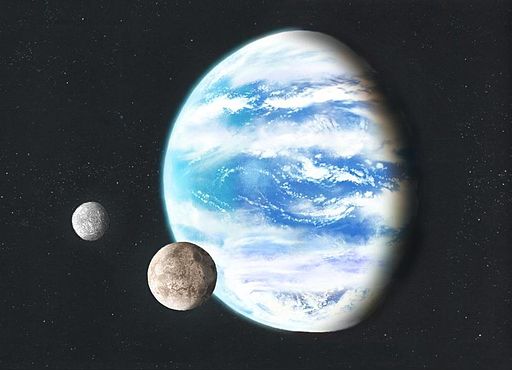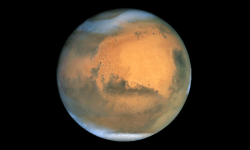
Water vapor detected on K2-18b, a habitable exoplanet ?
– News of September 17, 2019 –
Of the 4000 planets discovered outside the solar system, the vast majority are completely hostile to life. Whether they are too massive, too close or too far from their star, it is hard to imagine how liquid water and potentially life could find refuge on them. There is however a small catalog of exoplanets whose conditions are certainly more lenient. K2-18b is one of them. Located about 120 light-years away, it is located in the habitable zone of a red dwarf. It is about eight times more massive than the Earth and most likely in synchronous rotation with its star, that is to say, it always shows the same side, like the Moon with the Earth.
This is not the best candidate we know in the search for a twin of our planet, but K2-18b is currently becoming the star of the exoplanets. After a double announcement on September 10th and 11th, two teams working on the same observation data announced almost simultaneously the discovery of water vapor in the atmosphere of this exoplanet. H2O would also be present in large quantities, certainly with clouds and rain.
This is not the first time that water vapor has been detected in the atmosphere of an exoplanet, but the previous discoveries concerned gaseous giants. K2-18b is a much less massive planet. Its water cycle can therefore in part resemble what we know on Earth. But don’t imagine quiet seas and green meadows. K2-18b is very different from our planet. Its atmosphere is very dense, certainly reaching several millions of pressure bars.
We are not even sure it has a rocky core. If it has one, the core is surrounded by a thick layer of hydrogen covered with water vapor. There is no surface on which seas or oceans could be formed. If we add to that that days or nights are permanent, it is not idyllic to settle on it. It is possible that a primitive form of life can develop in such conditions, but it will be very hard to confirm at 120 light-years away.
The discovery of water vapor in the atmosphere of such a small exoplanet is, however, very encouraging. This observation was made possible thanks to the Hubble Space Telescope which recorded 8 transits of the exoplanet passing in front of its star between 2016 and 2017. Part of the light of the star crossed the atmosphere of K2-18b before reaching on the mirror of the space telescope. This light contains the trace of the chemical elements it has encountered. It leaves indeed absorption lines in its spectrum. The same technique could be used to study even smaller exoplanets, potentially of the size of the Earth.
This requires a larger mirror, for example the James Webb Space Telescope. The future large space telescope will be able to follow this technique by continuing the observations of K2-18b. This may be the opportunity to discover other atmospheric gases and thus understand a little better this type of planet that does not exist in the solar system. The announcement we all expect is obviously the discovery of water in the atmosphere of a rocky exoplanet located in the habitable zone of its star. Let’s be optimistic this may be in the next decade.

In search of an habitable exoplanet more welcoming than the Earth
– News of September 3, 2019 –
In our search for habitable exoplanets, we have an absolute referent, the one we know best, that is to say the Earth. So we try to discover planets of similar size and mass to Earth, with a particular interest for the exoplanets that are most likely to offer the same conditions of temperature, atmosphere of chemical composition. This approach is intelligent because in this way we think we can discover life. If we managed to find a perfect twin of our planet, if not being inhabited it would be at least habitable.
But is the Earth really the absolute referent in the search for life or could some planets with slightly different conditions be even more fertile? This is the question that a group of researchers sponsored by NASA has asked. They tried to determine the ideal parameters for the emergence of life as we know it. Surprisingly, the result is a type of planet quite different from ours.
At the heart of the questions of habitability of an exoplanet, there is the liquid water and the oceans. The oceans would ideally be a little different from those of the Earth. To feed, a primitive life needs the light of its star that can be found near the surface and marine sediments that are found rather at the bottom of the oceans. Marine currents that brew sediments and bring them back to the surface are therefore essential to bring all the right conditions to the right place. On Earth, these phenomena of upwelling of nutrient-laden waters occur mainly near the coast.
Starting from known exoplanets, the research team conducted more than 4000 simulations to determine if certain conditions could lead to even greater upwelling phenomena than on Earth. And the answer is yes. The best results appear for planets that have a lot of water, a thick atmosphere, continents and very long days. It is this little detail that is missing from the Earth to reach the top of the ranking of habitable planets.
Typically, if Venus once had oceans and continents, with her days of 217 terrestrial days she offered almost perfect conditions for life. Of course, this is only a model and is relevant primarily for primitive marine life based on photosynthesis. Other conditions are probably necessary to allow this life to become more complex and why not evolve towards an intelligent life.
The results of this work still give some additional leads in the search for habitable exoplanets. The conditions mentioned above are undetectable with the current means that astronomers have. We can hope, however, that the next generation of space and ground telescopes will begin to give us some clues about the atmospheres of terrestrial exoplanets.
As we have seen on Earth, the oceans and the atmosphere interact very closely. It may be possible, therefore, to discover in these atmospheres chemical markers giving some indications of the possible presence of an ocean and the conditions that govern it. With this meager information, we can then optimize the design of the next generation of telescopes. It is a long and tedious process but one that may lead us one day to the irrevocable conclusion that we are not alone in the universe.
Image by NASA/Ames/JPL-Caltech [Public domain]









